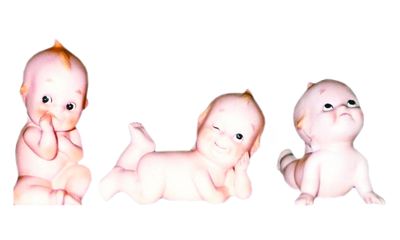Piano angels could leave you sitting pretty

Dear Collector: Enclosed find photographs of what I believe to be Kewpie dolls. They were made by a company named Lefton and presented to me approximately 50 years ago.
Slightly similar in appearance to kewpies, these vintage porcelains are described as “piano babies,” because they were often positioned on pianos. Like other bric-a-brac, they could also be sited on shelves or mantles.
Upon closer look, I notice they sport small, almost vestigial wings. So, I guess we could call them piano angels.
Lefton China, located in Chicago, usually distributed wares imported from Japan. Your precious putti (or cupids) have a current value of $20 to $30 each.
Dear Collector: I was given this 1899 one-dollar silver certificate by my father 60 years ago. I would like to know if it has any value.
A little tattered at the edges (aren’t we all), your large-size note is now worth at least $20. In 1899 the almost 75 million people living in this country were paying on the average 5 cents for a loaf of bread and two-bits per gallon of milk. Typical yearly income was about $400.
Dear Collector: Here are some photos of my “Tom Swift” game that was a gift on my eighth or ninth birthday. As far as I can see, everything is still in the box. What could it be worth?
Swift, a boy inventor who is the hero of a series of juvenile novels, is the focus of this space adventure board game. After viewing the box cover with its super-duper 1960s graphics, it’s not surprising that your childhood keepsake has a potential value of more than $200.
Dear Collector: This “Thomas, Sevres” plate was left to me by my Swiss grandmother. Can you give me some idea of its value?
Dated to precisely 1908, this piece of porcelain was made in the Bavarian city of Marktredwitz, which literally translates to “market talking joke.” It’s stamped “hand painted”; I have a feeling the floral patterns consist of hand work and decaling, a type of transfer decoration. That being the case, value is in the $20 to $30 range.
Dear Collector: This hammer belonged to my husband’s grandfather, and has not been used in probably 50 years. Can you tell me how old it is?
I found your bricklayer’s hammer in a copy of the 1926 Stanly Tools catalog, where it retailed for $1.90. Today, it is valued at $30.
Dear Collector: I’ve been told that I have a Hollywood Doll. When was it made?
Assuming that is what you have, it would date from the 1950s. Check between her shoulders for a star or the words “Hollywood Doll,” though neither may be there. Called a shelf doll due to its small size, this inexpensive plastic toy is still a favorite with collectors.
Dear Collector: I found a copy of “The Electric Cook Book” among my late mother’s things. The recipes are a riot. Is it worth anything?
Published in 1959, this paperback has a listed value of $15.
Dear Collector: We just inherited a granddaughter clock. Why is it called that?
Because it’s a petite grandfather clock?
Recommended reading: “America’s Money, America’s Story: A Chronicle of American Numismatic History,” Richard Doty (Whitman Publishing, 2009, $26.95).